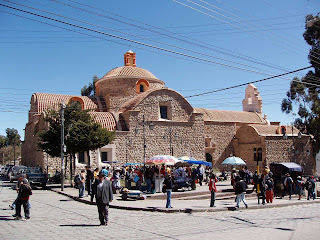 |
| Historic City of Sucre - Bolivia |
Short Report
Sucre, the first capital of Bolivia, was founded by the Spanish in the first half of the 16th century. The many well-preserved 16th-century religious buildings, such as San Lázaro, San Francisco and Santo Domingo, illustrate the mix of local architectural traditions styles imported from Europe.
Wide Report
The rich heritage of the historic center of the Spanish city Sucre (also known as the city of four names - La Plata, Characas, Ciudad Blanca and Sucre) is an excellent, intact and well-preserved example of the architectural mixture reached in Latin America through the assimilation of local traditions and styles from Europe.
The city of La Plata was founded by Pedro Anzures, Marqués de Campo Rotondo, in 1538. The foundation is a result of the mining activities under the watchful eye of Gonzalo Pizarro, who is interested in exploring the highland east region the Andean Cordillera. In 1559, the Spanish king Felipe II commanded the foundation of the Audiencia the Characas, with headquarters in the city of La Plata, for the management of the eastern regions. The Audiencia which judicial authority and executive powers, and the regions of Paraguay, the south-east of Peru, northern Chile and Argentina, and the most of Bolivia. The Spanish city was designed on the basis of a simple urban program, as all cities founded by the Spanish in the regions of America in the 16th century. The mineral wealth of the nearby town of Potosí influenced by the economic development of La Plata, which was also a major cultural center (Universidad San Francisco, Royal Academia Carolina San Isabel Hungria Seminario), and the headquarters of the Characas Audiencia, a precursor of the current Supreme Court.
In 1609 the city was the seat of an archbishopric, and in the 17th century La Plata served as a legal, religious and cultural center of the Spanish eastern areas. The first call for the independence of the Americans took place in the city of La Plata in 1809. In August 1825 independence was declared and a new republic was born under the name of Bolivia. In the same days the name of the city, La Plata, was changed in Sucre in honor of Mariscal Sucre António José, who fought for independence from Spain. The buildings in the historic center of the city are characteristic 18th-century local architecture and are similar to those built in the same period in the. More recent buildings (late 18th and early 19th century) is still a patio, but they are tailored to the neoclassical style of metropolitan Spain. The House of the Freedom is considered to be the most important historical monument of the country, as it was here that the events that led to the independence of Bolivia has taken place. It was built in 1621 as part of the Monastery of the Jesuits.
On the other hand, many religious buildings still testify to the period that marked the beginning of the Spanish city, including the churches built by settlers from the 16th century, such as San Lázaro, San Francisco, Santo Domingo and the Metropolitan Cathedral, the construction of which began in 1559 and was not completed until 250 years later. The architecture shows Renaissance, Baroque and Mestizo pop would be described as pop. 'Baroque' functions. The church of Santa Barbara is the only church in renaissance style in Bolivia: the interior construction, neo-gothic style, dating back to 1887. All churches of Sucre illustrate the mix of local architectural traditions styles imported from Europe.
Source:whc/unesco

No comments:
Post a Comment